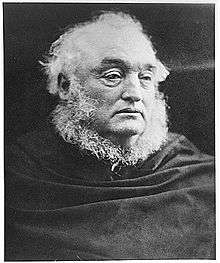William Milbourne James (judge)
| William Milbourne James | |
|---|---|
|
from a painting by John Hollins concerning the record balloon flight[1] | |
| Born |
1807 Merthyr Tydfil, Wales |
| Died |
7 June 1881 London, England |
| Nationality | Welsh |
| Education | Glasgow University |
| Occupation | Judge |
| Known for | Vice-Chancellor |
Sir William Milbourne James (1807 – 7 June 1881) was a British judge.
Life history
James was born in Merthyr Tydfil, Wales in 1807 to Christopher James a prosperous provision merchant.[2] His cousin was Charles Herbert James, who later became Member of Parliament for Merthyr Tydfil.[3] He was educated privately at the school run by John James of Gellionnen before entering Glasgow University. He was called to the Bar from Lincoln's Inn in 1831.[2]

James first practised his legal work around the South Wales circuit, but later switched his activities to his Chancery practise.[2] In 1836 James was included in the preparations for the record breaking balloon trip funded by Robert Hollond and he was amongst six people included in the commemorative painting which is now in the National Portrait Gallery in London.[1]
During his legal career, he held the posts of Junior Counsel to HM Treasury in Equity, Junior Counsel to the Woods and Forests Department, the Inland Revenue, and the Metropolitan Board of Works.
In 1846 James married Maria Otter, daughter of William Otter, Bishop of Chichester.[2] In 1853 he became Queens Counsel. In 1869 he was made a Knight Bachelor, and appointed as Vice-Chancellor. In 1870 he was appointed Lord Justice of Appeal and a Privy Councillor, which entitled him to sit on the Judicial Committee of the Privy Council.[4] He was also a member of the Reform Club.
While a Lord Justice of Appeal, he decided Lambe v Eames (1871) LR 6 Ch App 597, which is a leading case on the construction of declarations of trust.
In 1880 he was considered for the nomination to the Merthyr Tydfil seat when his cousin was elected, but by that time James had lost touch with Welsh affairs and had little interest in the Welsh national movement.[2] He died the next year in 1881 at his London residence.[2]
Judgements
- Tamplin v James (1880) 15 Ch D 215 (CA), upholding a decision of Baggallay LJ in the first instance; contract law concerning the availability of specific performance for a breach of contract induced by mistake.[5]
References
- 1 2 Portrait of James (and others) at the National Portrait Gallery
- 1 2 3 4 5 6 Lloyd (1958), pg 428.
- ↑ Lloyd (1958), pg 420.
- ↑
- Brief biography, Amazon, accessed May 2009
- ↑ "Contract - General Principles - Remedies - Specific Performance and Injunctions - Specific Performance". The Laws of Australia. Thomson Reuters. 31 August 2006. pp. [7.9.1450].
Bibliography
- Lloyd, John Edward; Jenkins, R.T. (1958). The Dictionary of Welsh Biography, Down to 1940. Cardiff: William Lewis.
| Legal offices | ||
|---|---|---|
| Preceded by Sir George Markham Giffard |
Vice-Chancellor 1869 - 1870 |
Succeeded by Sir James Bacon |
